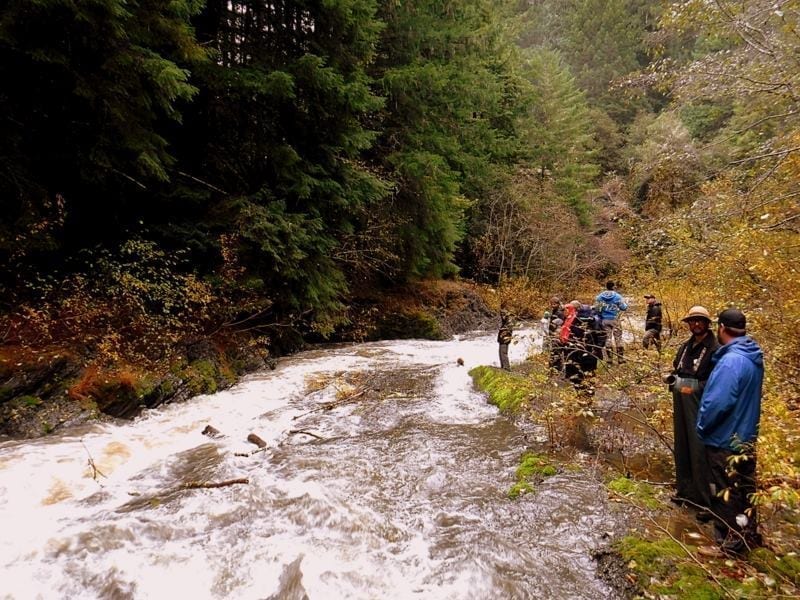Eel River Salmon Spawning Pop Up Tour Recap
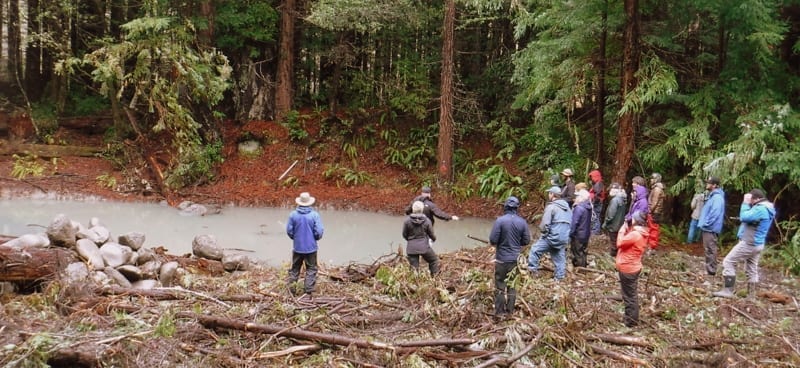
Can you see any salmon spawning? Photo: Loleta Eric’s Guide Service
The winter rains did not scare away the 25 participants who came to the Pop Up Salmon Spawning viewting tour on the Eel River on Saturday December 1st. The event was hosted by California Trout hosted and led by Eric Stockwell of Loleta Eric’s Guide Service.
Here’s Eric’s recap of the day:
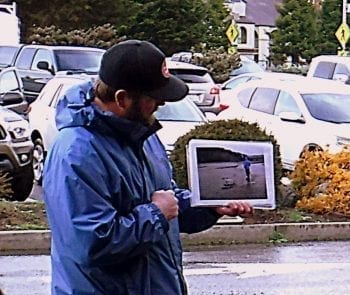
Matt G. of NOAA Fisheries shares photos of a fish kill on the lower Van Duzen early this century. Photo: Loleta Eric’s Guide Service
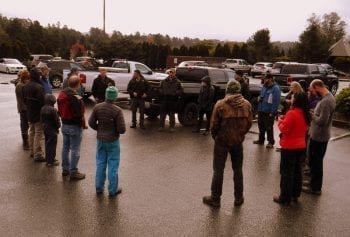
Tour participants gather round to hear from presenters about the history of the Eel. Photo: Loleta Eric’s Guide Service
Today’s tour was pretty awesome. We had an all-star lineup of speakers and guests at the Riverlodge from 9AM to about 1030. Big thanks to CDFW wardens Matt Wells and Eric Agoitia who gave us an overview of the challenges they face in the field. Matt’s description of the Eel River fisheries being a uniquely tough situation really hit it on the head – in a catch and release fishery with big game fish there is a temptation that’s automatically created. Another strong point that warden Wells made was that even though Eel salmon and steelhead are listed as either threatened or endangered, any consideration of disallowing fishing will bring with it the risk that we as a community and a culture lose even more connection to the river, the wildlife and the habitat. As a guide, I totally agree with that assessment, and trying to bridge the gaps between the citizenry and the landscape is very high on my list of aspirations. Our next presenter was Matt Goldsworthy of NOAA Fisheries who gave us an overview and history of gravel mining and river form and how they relate to the salmon runs. Matt made great points about the progress that has been made in terms of gravel skimming versus trenching, and I was super excited to hear him speak of a plan to put some structures in the lower river in an attempt to improve holding water for adult salmonids as well as overall habitat improvement. I was also very pleased that Margaret Tauzer – also of NOAA Fisheries – joined our tour group for the day and added to a rich exchange of learning and ideas. Our final presenter was Dennis Halligan of Stillwater Sciences. For over 20 years Dennis has tracked the lower Eel and other north coast streams for habitat, holding water, juvenile rearing, pool depth, ratios of holes to runs and riffles…etc., and his illustrations were spot-on regarding the current limitations on the lower Eel and Van Duzen regarding the needs of the salmon runs. A very valuable advisory from Dennis was that it’s apparent from his work that nature holds most of the cards regarding flows and how things stack up for fish in the late summer and into the fall when low flows can have significant negative impacts on adult fish. That said, I think that we had consensus regarding the need for big structures in the gravel desert that is the lower Eel. Last mention here regarding our special guests: Scott Downie, a retired CDFG manager who really made an impact in our area (and continues to!) added to the discussion and is a wealth of information about work in the not so distant past that appears to be very relevant right now. It’s always a pleasure to spend time with Scott, and all of our presenters were fully engaged with the tour participants today – couldn’t have gone better!
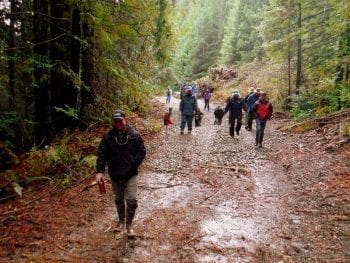
Making our way to a new off-channel habitat feature that represents the cutting edge of putting things back to fish-friendly. I think it’ll take literally hundreds if not thousands of projects like this to help get momentum building toward abundance in our fisheries. It starts in places like this. Photo: Loleta Eric’s Guide Service
Once we were done with the purely educational part of the day (and a crazy thunderstorm that had us dodging for shelter under the eaves of the Riverlodge) we headed out highway 36 to Yager Creek where we’d hope to see some spawning salmon. Big thanks are due for Keith Lackey, Humboldt Redwood Company fisheries biologist, who joined us for the day, took us up onto HRC lands, and gave us information on our stops along Lawrence Creek. We started off by going right to a prolific spawning riffle where we were able to see a half dozen or so adult Chinook even though the water was relatively turbid from the recent rain. Next we toured a new off-channel habitat project that was just completed in October of this year, and we finished up down at the cascade at the mouth of Lawrence where we had a chance to see fish entering the stream. Just as 20 of us lined up for a group photo, Keith spotted a bald eagle above us, and the day was complete.
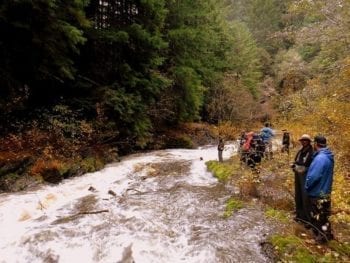
Final stop in the field – the Cascade. Photo: Loleta Eric’s Guide Service
The bottom line for this tour was the idea that our culture needs stronger ties to the natural resources that can provide for a rich future here. The participants and presenters and the guides all share a passion for and concern about the fish and their habitat, and that energy is what must spark the fire that leads to change here. We can improve habitat and take measures to help fish all we want, but if we don’t find a way to wake the entire culture to the potentials of healthy streams and strong fisheries then we may only be spectators in the decline of what I see as our true heritage here on the Eel in the Salmon.
Big thanks to Darren Mierau, Mary Burke, and Megan Nguyen of CalTrout for the collaboration that made this tour possible. Expect more opportunities like this in the future.
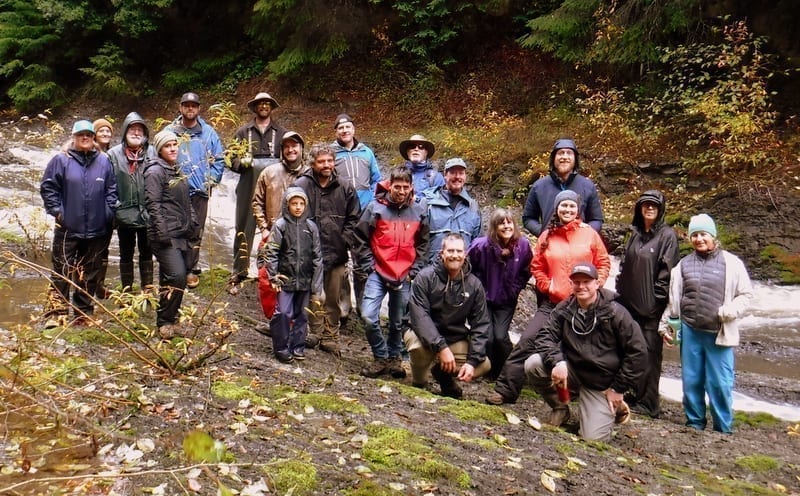
Thanks for coming! Photo: Loleta Eric’s Guide Service


